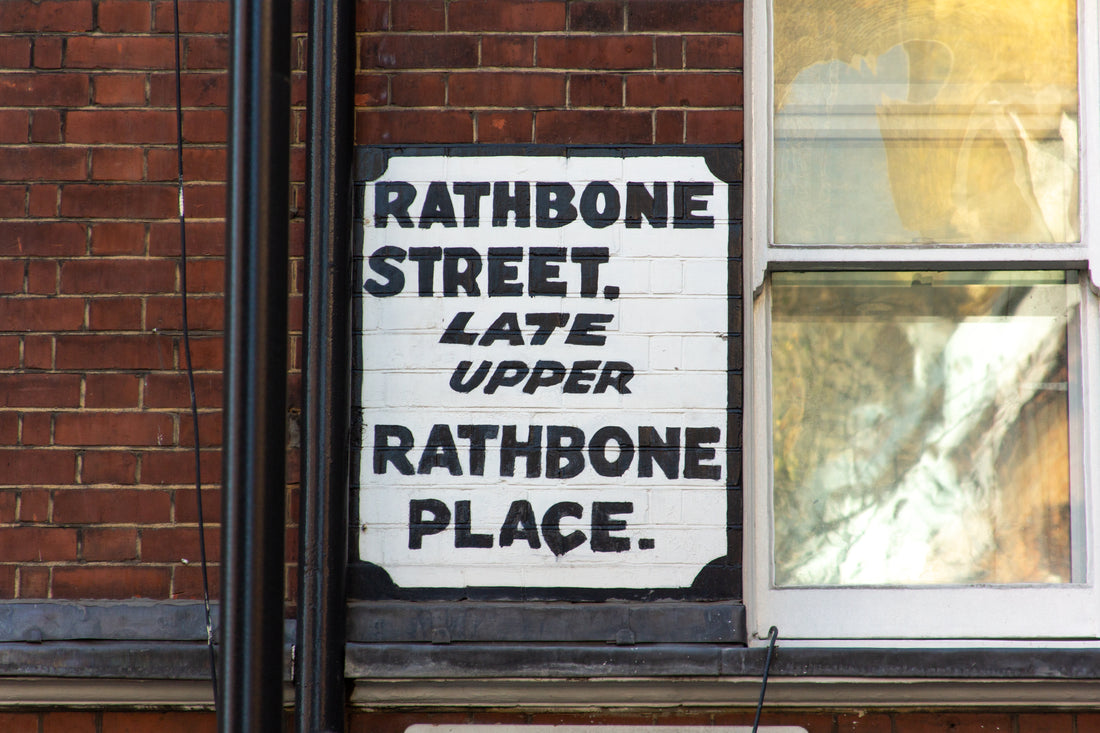
Discover London’s history through its street signs
Share
Alistair Hall, graphic designer and author of the London Street Signs Map, tells us about the craft behind London’s nameplates and how they can be interesting entry points into the city’s history. Plus, he suggests an excellent afternoon itinerary for a walk with the map.
What interests you personally about street signs? When did you become interested in them and why?
Well, like most designers, I’m a sucker for a tasty bit of lettering in the environment. I was lucky enough to study Graphic Design at Central Saint Martins, where I was taught by two wonderful typographers, Phil Baines and Catherine Dixon. They took us on regular walking tours around London, during which they’d point out fantastic examples of type and lettering on the walls of the city.
Many years later, in November 2016, I moved into a new studio on St Cross Street EC1, just off Hatton Garden. The street had an old milk-glass Borough of Holborn nameplate, and it struck me that I’d never seen the lettering on it used in print anywhere. I began to wonder where it came from… and things rather snowballed from there!
The more signs I found, and the more research I did into them, the more I realised they were fascinating not just as examples of beautiful graphic design, but also as entry points into London’s history. And I thought it would be good to share that history with as many people as possible.

The iconic Abbey Road sign in London, a site of pilgrimage for Beatles fans. Photography: Alistair Hall
Which would you say is your favourite street sign on the map and why does it appeal to you?
Ah heck, this is tricky! There are so many brilliant ones. You know, I’m going to say the humble little sign for Ball Court in the City of London (No. 31 on the map). A tiled sign, it’s a plucky little survivor in a sheltered alleyway, of a type that used to be common right across the city. It’s a bit like it’s the last of its species – it deserves our love.
As a graphic designer working within your studio We Made This, have you ever designed a sign or nameplate? (Or anything similar)
I’ve done a lot of temporary signage, but nothing permanent. I’d completely love to work on some nameplates. There are a few fantastic examples of recent ones out there – and far more absolute howlers! It seems it’s quite rare for graphic designers to be involved in street sign design, which is really peculiar, especially when you see the great results when they are involved. For instance, the City of Westminster nameplates designed by Design Research Unit, or the more recent Lambeth nameplates by Atelier Works.

The London Street Signs Map
What makes a good, well-designed nameplate?
Historically they were created by skilled craftsmen, who would tailor the lettering to the specifics of each set of letters, and the space available, on each sign. That human quality is much to be admired. Fortunately, modern typesetting allows us to recreate that experience – as long as a designer is involved! A really good nameplate should be well manufactured in an appropriate material – we have the evidence all around us that well made signs can last well over a century. A thoughtful choice of well spaced lettering, which is not just functional, but also appropriate to its locale is essential. Signs that are well designed and made can really enhance the space around them, and even engender a sense of local pride in the people who see them.
How does a graphic designer experience a layered city such as London?
We spend most of our time getting annoyed about badly spaced lettering (and don’t get me started on the misuse of apostrophes!). I guess like most creative folk, we’re visual magpies… always having our heads turned by a fancy piece of lettering or an intriguing colour combination. London is so rich, visually, and changing so constantly, that there’s always something new to distract you.

Applied lettering on a supporting frame at Gower Street. Photography: Alistair Hall
Can you suggest a little afternoon itinerary for people walking with the map?
Using the highlighted section of the map, this would be a fine way to while away an afternoon in London:
Start in Trafalgar Square (7), and head up Haymarket to Regent Street. Check out the tablet on Lower John Street (2) and the architectural lettering outside the West End Central Police Station at the junction of Savile Row (1) and Boyle Street. Continue up Regent Street and head west to Great Marlborough Street (3) where you could stop in at Liberty of London for a spot of shopping. Perhaps drop in at the fantastic Photographer’s Gallery (16-18 Ramillies St, W1F 7LW) too while you’re in the area.
From there meander through Soho, stopping at Wardour Mews (4), before grabbing a delicious coffee and pastry at Princi (135 Wardour Street, W1F 0UT). Dip down to Meard Street (5) before heading north to Store Street South Crescent (21). Wander across to the London School of Hygiene and Tropical Medicine at Gower Street and Keppel Street (20), and marvel at the gilded lettering, and spot the flea, tick, mosquito and rat which also adorn the building!
From there I’d amble down to the cluster of Borough of Holborn milk-glass signs at the junction of Great Russell Street and Bloomsbury Street (19), by the British Museum, before heading down to Lincoln’s Inn Fields (13). Make sure to drop in at the marvellously eclectic Sir John Soane’s museum (13 Lincoln's Inn Fields, WC2A 3BP) if you have time!
From there head south east along Great Queen Street towards Covent Garden, past the imposing Free Mason’s Hall, and onto Long Acre. Turn south on Bow Street, and see if you can spot London’s oldest street sign, three floors up on Tavistock Street (8). The unmissable London Transport Museum (The Piazza, WC2E 7BB) is nearby, but you’ll surely be a tad thirsty by now, so why not head to the Lamb & Flag (33 Rose St, WC2E 9EB) for a much deserved pint!
While you’re wandering along, make sure to keep an eye out at every street corner – there are many more stunning signs to be seen along the way! And if you’d like to know more, do check out my book, London Street Signs.
